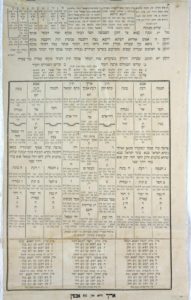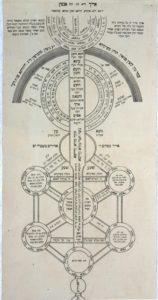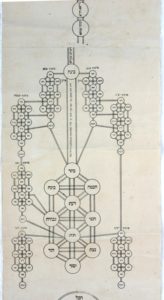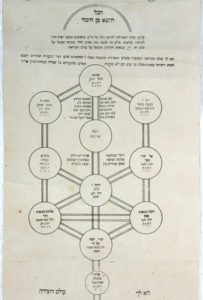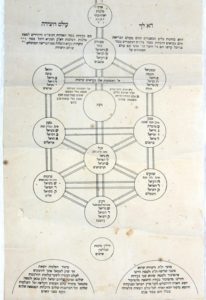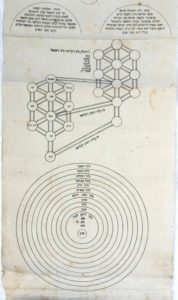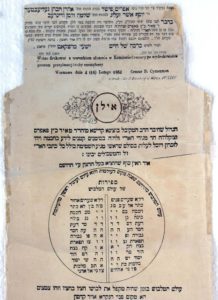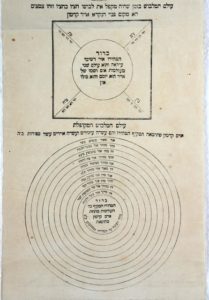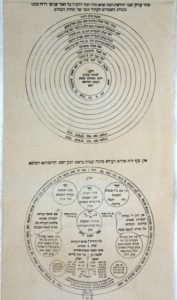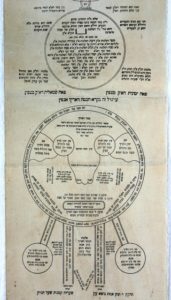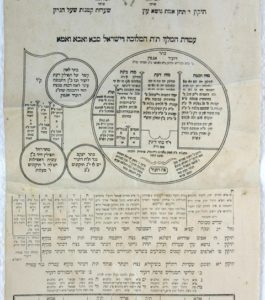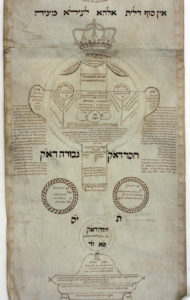Gross Festschrift Contribution – J. H. Chajes & Eliezer Baumgarten
In a volume of essays presented as a beautiful bouquet to its distinguished and deserving recipient, there will no doubt be no few declarations of the signal importance of a given subcollection. Some, like the collection of magical artifacts, are certainly to be counted among—if not atop—the world’s greatest. Thanks to the legendary-yet-true generosity of William Gross, whole fields of scholarship are nourished by these collections. It is likely nevertheless that with regard to only one can it be said that a whole field of scholarship was created by the collection, and, no less truly, by the collector: the Gross Ilanot Collection.
If, dear reader, you are now asking yourself, “Ilanot?”—without a clue regarding the meaning of this odd italicized term, you are not alone. You are, however, less alone than you might have been just over a decade ago. Ilanot is the plural form of the Hebrew ilan, or “tree,” but in this context refers to an entire genre of Judaica. His keen eye having chanced upon them, William Gross began collecting ilanot decades ago for their undeniable aesthetic interest. His best academic sources could not, however, tell him anything about them; they had never been studied by scholars of Kabbalah. Undeterred, our hero contracted an erudite scholar—Dr. Menachem Kallus—to provide him with initial descriptions of just what these ilanot depicted. A longstanding friendship with Dr. Kallus brought them to Prof. Chajes’s attention soon thereafter, and, with the realization that an entire of genre of Judaica was terra incognita in the twenty-first century, the Ilanot Project was founded with the support of the Israel Science Foundation. But we get ahead of ourselves.
The genre was defined by the name “Ilanot” some five hundred years ago as the wedding of schema and medium: a diagram (originally arboreal) inscribed on a parchment sheet. The tree of sefirot—the ten divine qualities at the core of kabbalistic theosophy—is, of course, well known, even iconic.

Yet as early as the fourteenth century, kabbalists did more than simply diagram these sefirot on the pages of their treatises: they enlarged them to fill dedicated parchments. In and around them, they inscribed in loco texts relating sefirotic names and associations. These poster-sized creations were regarded as a genre in their own right for good reason: in form and function(s), they were literally like nothing else. As images, they represented the topography of the Godhead as kabbalists believed it to be “in reality”—this in an age during which depictions were presumed bound to the depicted through the occult networks established by similarity itself. These maps of God thus made the divine territory present for their users. As parchments, ilanot were one of a small number of (sc)rolls in use among Jews: the rest—sifrei torah, mezuzot, etc.— were all used in ritual contexts rather than for quotidian study. Ilanot, then, should not be understood simply as kabbalist texts presented by means of an eccentric format, but as performative artifacts.

If we put these two dimensions together, the nature of ilanot becomes clear: they establish a kind of virtual divine reality that invites the participation of their user. Early ilanot, such as the rare fifteenth-century parchment here pictured, could be contemplatively studied and committed to the mind’s eye—or simply gazed upon—in the/as an act of prayer. Especially after the revival of the genre in the mid-seventeenth century, at which point multiple-parchment ilanot rotuli (vertical rather than horizonal scrolls) of unprecedent length were created, the very act of scrolling became central to their performance. As these early modern ilanot mapped the Godhead in its developmental dynamism, from the highest to the lowest of its emanations, to scroll through an ilan in a state of contemplative, imaginative identification with virtual divine reality brought the kabbalist an intimate and immediate form of the knowledge it represented. The ilan had other functions as well: pedagogic (introducing complex cosmology diagrammatically), hermeneutic (settling questions of how the divine topography described in texts was to be pictured), mnemonic (placing texts in specific locations for subsequent recollection and creative redeployment), and even apotropaic (warding off evil as amulets). This, in short, is the genre that William Gross is responsible for rescuing from undeserved obscurity.
As kabbalists fashioned ilanot wherever they were over the past seven centuries, from London to Mabar (a village south of Sana’a, Yemen), the cultural and ideational variegation of the genre is staggering, and the process of writing its history arduous and interdisciplinary. Of the innumerable potential chapters in such a history, a small but fascinating one will be written on the following pages—one that especially honors the aesthetic eye that first spotted an ilan so many years ago. For if it is true that an ilan is, as its name suggests, first and foremost a tree, peering out from that odd parchment roll on the auctioneer’s block was a face—and not just any face, but a face of God.[1] What are these faces of God doing in kabbalistic, let alone Jewish works? If the myth of the artless Jew (and Jewish aniconism more generally) is long shattered, how could we not be astonished upon seeing a face of God depicted representationally on a kabbalistic artifact? The Second Commandment is one thing, but the words of Exodus 33:20 ring memorably in our ears: “You cannot see my face: for no man shall see me and live.” Yet there they are, these faces, in ilan after ilan.
Before even seeing examples of these faces, however, it is important to make two points: one regarding specific content, and the other regarding esotericism generally. First: the faces of God that we see on ilanot appear for the first time in the second half of the seventeenth century. They are not part of the ilan in its classic form, which, as we noted, was dominated by the arboreal schema. The sixteenth-century emergence of Lurianic Kabbalah—named after R. Isaac Luria (1534-1572)—made all the difference. Luria did not invent a new system from scratch, but his readings of the central corpus of the medieval tradition, the Zohar, so thoroughly de- and reconstructed its most recondite compositions—the so-called Idrot (lit. “threshing floors”)—that to many it has often seemed that he did. Before Luria, most kabbalists occupied themselves with the ten sefirot. As archetypical qualities or categories, they provided the keys to understanding (and acting upon) the underlying structure of creation and its Creator. They were the cyphers to the secrets of the Book of Nature and the Book of God, understood as encoded sefirotic sequences. Not coincidentally, like the categories of Aristotle famously diagrammed by Porphyry in his eponymic diagram, the sefirot were best represented diagrammatically as a tree. Luria had paid particular attention, however, to the images of the Godhead in the Idrot. These were of an altogether different character. In them, Luria discovered the elements that would form the heart of his own teachings. Rather than the undifferentiated infinite and unknowable deity Ein Sof (No End) simply emanating the sefirot as in classical Kabbalah, here emerges Adam Kadmon (Primordial Adam)—a cosmic figure of human form, the human form in whose likeness and image we were created. The great variety of creation was, in this account, rooted ultimately in the unique qualities of the lights that streamed from each of the orifices of Adam Kadmon’s face, which included not only nostrils and mouth, but ears and eyes. Even the beard of this macanthropos was instrumental to creation. The face of Adam Kadmon was not alone, however.
It was still true that “no man sees my face and lives” (to use Bob Dylan’s “I and I” paraphrase). The face of Adam Kadmon could not simply emanate creation as we know it in our material world. It was, rather, only the first link in a great chain of being, or, more precisely, the first face. Lurianism describes the progressive diminution of the unimaginable supernal lights of Adam Kadmon; not unlike the electrical voltage powering our homes, these great lights had to be stepped down incrementally simply to allow for the very existence of a reality differentiated from the divine. The initial transformers of the primordial lights of Adam Kadmon are the divine faces known as partzufim (lit. faces). Prominent among these are Arikh Anpin (lit., “longface”) and Ze’er Anpin (lit., “short-face”). If Adam Kadmon is the anthropomorphic ur-figure in this system, it is nevertheless still an ungraspable dimension of the deity—and still at considerable remove from a “personal God” of the kind we encounter in classical Judaism. Arikh, though “lower” than Adam Kadmon, remains a face of God of sublime equanimity, nonplussed by the ebb and flow of human history or the good and evil of human actions. With Ze’er, however, whose name suggests a God with a short temper for the first time, we arrive at a familiar face of the divine: this face of God smiles or frowns, depending on you. And finally, to the matter at hand: these are the faces of God we find in the Lurianic ilanot produced from roughly 1650 forward.
There was therefore a solid basis in Lurianic Kabbalah, based on the zoharic idrot, to represent the faces of God in artifacts devoted to mapping the structures and dynamic development of divine realms. That basis did not, however, constitute “permission” to do so, and, a fortiori, certainly not in the public domain. The teachings of the idrot were palpably troubling to their writer, who introduced them with a stern warning voiced by their protagonist and hero, Rabbi Shimon bar Yochai, echoing the Second Commandment. Although the teachings were of unprecedented anthropomorphism and “plasticity” in their representation of the Godhead, the student was not to take them literally, making of them a “graven image.”
The idrot were included in the zoharic literature published in the midsixteenth century as “the Zohar”—despite vocal rabbinic opposition to its printing. The canonical redaction of Lurianism, Etz Hayyim, would be printed (by a maskil!) in the late eighteenth century. Only in the latter half of the nineteenth century, however, would Jews print a Lurianic ilan.
Although in the end, commercial interests seem always to prevail, it would seem that the centuries of reticence were borne of a consensus that ilanot were not for everybody. They were, at least until the Warsaw printing, made exclusively by kabbalists, for kabbalists. It was not simply the complexity of their content that called for discretion—it was all to be found in Etz Hayyim and other printed books after all—but their graphical visualization.[2] All of this to make our second point: our surprise at seeing the faces of God inscribed on a kabbalistic parchment is well placed.
We are not the first to find these images audacious. In the event, our sensibility offers a useful insight into the perceived need to transmit these artifacts within the community of kabbalists equipped to understand them. Now that we too can understand these faces, let us see them.
The man responsible for the canonical redaction of Luria’s teachings (as mediated by R. Hayyim Vital, Luria’s most prominent disciple) was R. Meir Poppers, an itinerant Polish kabbalist. Poppers explained in his introduction to Etz Hayyim that the chaos of these teachings made it impossible to learn them; his editorial motivations were thus primarily pedagogical. It should not come as a surprise to learn that Poppers was also the first to sketch a diagram of Adam Kadmon and the partzufim, and that he did so for his students in Cracow around 1652. In his commentary to Etz Hayyim, Poppers writes that the plethora of theosophical detail found in Luria’s treatment of the reconfigured sefirotic structures (these being the partzufim) in the aftermath of the “breaking of the vessels” should not obscure the fact, writ large, they all served to “enrobe” Adam Kadmon. Continuing this very sentence, Poppers writes, “and in the ilan that I fashioned for my colleagues abroad, I represented all the details possible for me to draw; below we shall write the order of its enrobing.”[3] The Poppers’ ilan thus showed both Adam Kadmon and the partzufim, the latter in their progressive attenuations.[4]
Although we do not have an ilan carrying a colophon that dates it to the mid-seventeenth century that fits this description, a German scholar by the name of Christian Knorr von Rosenroth set out to collect ilanot in this period, regarding them as essential to the kabbalistic education of the readers of his Kabbalah denudata (Sulzbach, 1677). In this volume, Knorr published five ilanot over sixteen fold-out pages. The ilanot were prepared as engravings, and Knorr himself translated their Hebrew content into
Latin. The first of these five ilanot, presented in figures (fold-out pages) 1-7, precisely matches Poppers’ account of his ilan.
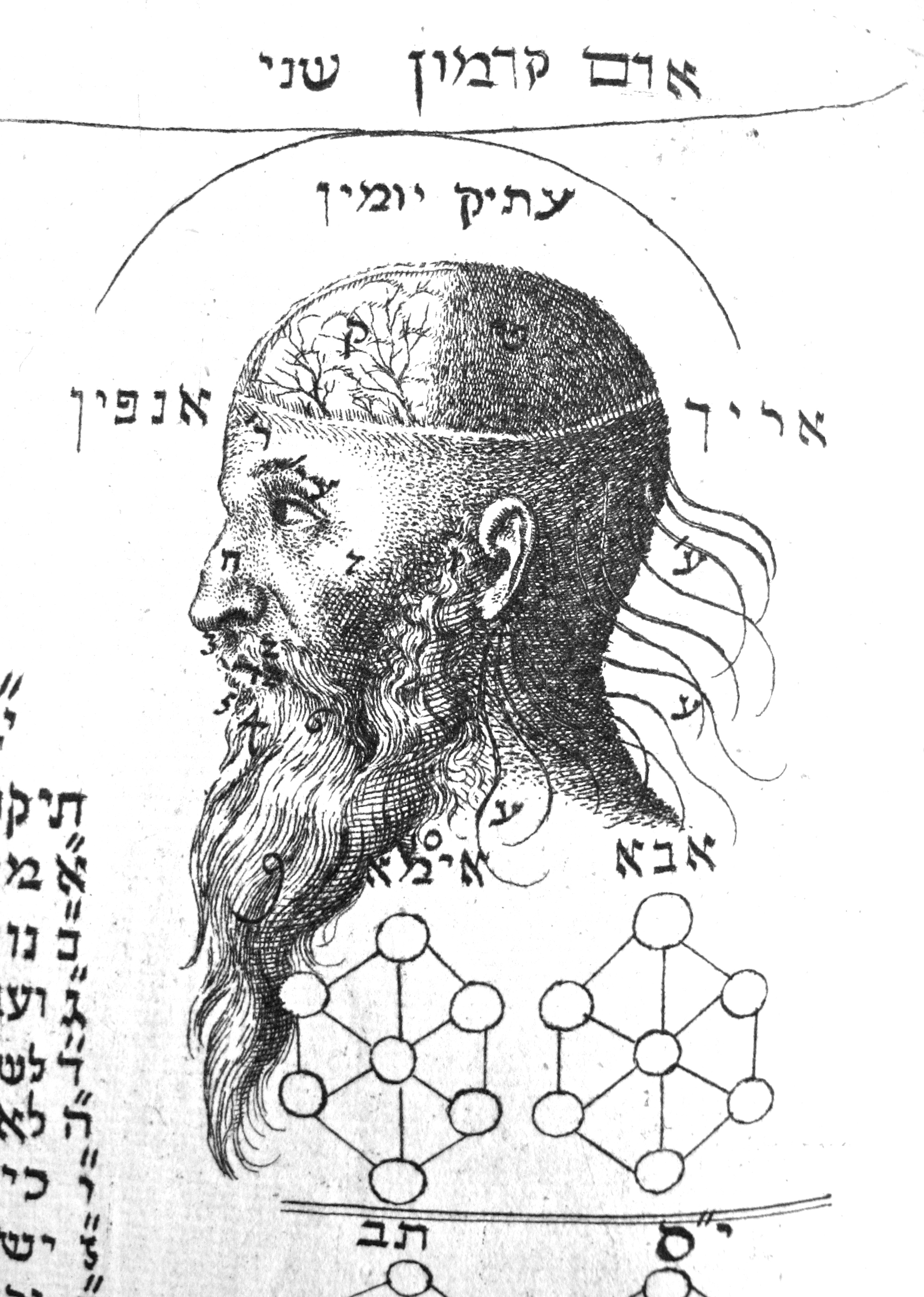
GFCTrust NHB.13
Relatively few witnesses of this ilan on its own have reached us, as kabbalists of the eighteenth century began to create hybridic rotuli in which previously independent ilanot were spliced together in succession. In these, the Poppers ilan was either the first or the second of sequence—and indeed the most ubiquitous recurring module of these compound ilanot. A rare example of a “pure” Poppers ilan may, however, be found in the Gross Collection.

GFCTrust 028.012.015
These early witnesses share in common an austere aesthetic. Isolating their representation of the face of Adam Kadmon, we note their primary reliance on micrographic textual inscriptions themselves to establish facial features.
These inscriptions and their schematic determination of the eyes, ears, nose, and mouth (among other features) of Adam Kadmon may have done the job, but no few of the kabbalist-scribes who have crafted ilanot since the late seventeenth century were men of some artistic ability who could not resist the urge to put their talent to work. Indeed, R. Israel ben Asher Buchbinder, who produced an astounding series of illuminated copies of Vital’s Etz Hayyim in the first half of the eighteenth century—each of which included a large, fold-out ilan sewn into the binding—signed his name on their frontispieces, “the scribe and the artist. (ha-sofer ve-ha-tzayar)”[5] In addition to drafting diagrams of great precision, many added decorative elements to these rotuli, including delicate floral motifs and animal iconography. They also lent the face of Adam Kadmon a more realistic appearance, delineating features with lines and circles, and, in some cases, using more elaborate techniques such as hatching and cross-hatching, particularly for hair, moustache, and beard.
A full range of representational possibilities was already explored by late seventeenth- and early eighteenth-century ilan makers. In the early 1700s, a German scribe produced GFC 028.012.010, a hybridic rotulus in which the Poppers ilan is the second of three. In its face of Adam Kadmon, we find lines and circles demarcating features still largely indicated by the size and arrangement of text.

At the other extreme, decades earlier, a Moravian kabbalist and scribe, R. Nossn Khazen Hammerschlag, allowed himself to create a Poppers-inspired ilan with considerably more representational imagery.
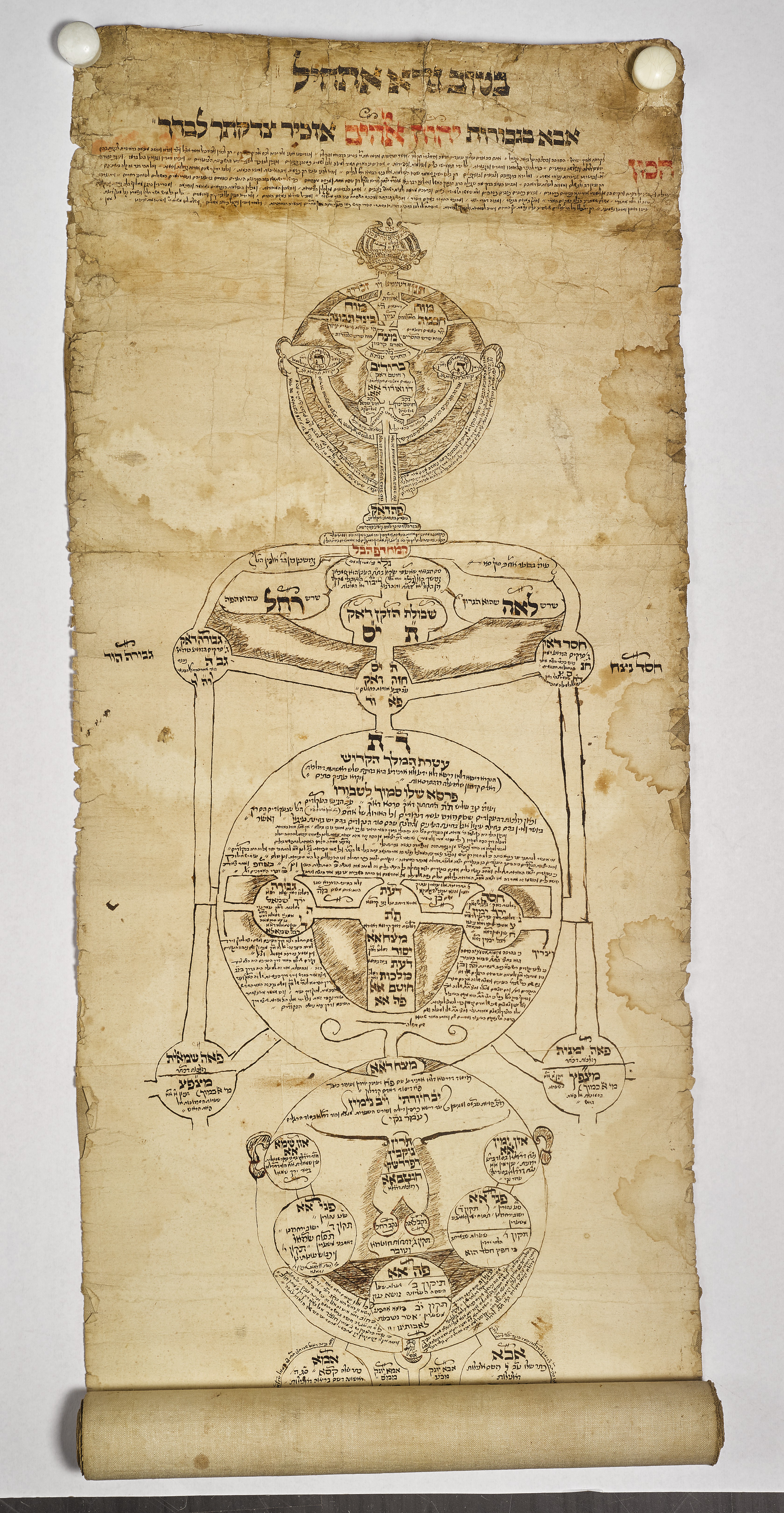
Hammerschlag’s Arikh and Ze’er Anpin were no less vivid than his Adam Kadmon, Ze’er even featuring
something of a curly Habsburgian mustache. He would take this approach to an extreme in the epic parchment he completed in 1691, titled “The Ilan of Adam Kadmon.”[6] In this latter ilan, Hammerschlag’s Adam Kadmon evoked Leopold I, the reigning Holy Roman Emperor, sporting the golden Imperial Crown that had been crafted in 1602 for Rudolf II.
By the mid-eighteenth century, elegant ilanot were being produced in Germany and Eastern Europe that figured Adam Kadmon, Arikh, and Ze’er with unmistakable albeit schematically rendered features. Lovely, though somewhat incongruous flowers grace some of these faces.
At times, faces of God seem to have been drawn with a view to conveying something of their distinct attributes, or even their emotional states. Adam Kadmon is sanguine, with a Buddha-like equanimity in the intriguing “Ilan of Holiness,” especially when viewed alongside the image of the partzuf that follows it. Arikh, the latter, seems positively stressed out by the increasing engagement with creation in its ever-busier lower expressions.
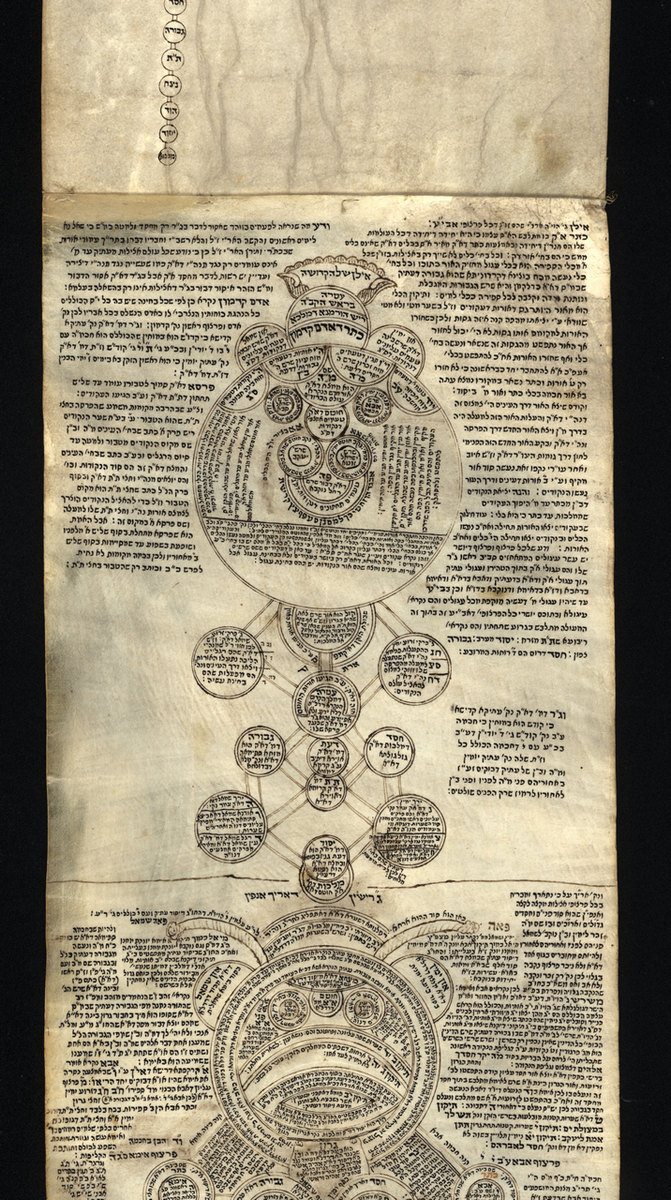
One might well wonder whether the anthropomorphism of the divine faces in the Poppers Ilan and its many copies and adaptations was influenced, or at least made possible by the Christian environment in which the ilanot thus far surveyed were produced. As plausible as such a hypothesis may be—and it may indeed be true— it is nevertheless the case kabbalists in the Muslim world were quick to embrace Poppers’ faces of God. From Morocco to the Land of Israel and Iraq, throughout the eighteenth and nineteenth centuries, the Poppers ilan was copied as well as selectively incorporated into a variety of novel ilanot. All of these preserved, if not enhanced, the anthropomorphic representation of the divine faces. R. Isaac ben Michael Coppio, a North African kabbalist of the second half of the seventeenth century and the first half of the eighteenth, created distinctive ilanot the
popularity of which (judging by the number that have reached us) was only slightly less than the hybridic “Great Tree” (attributed whole cloth to Poppers, as in the 1864 Warsaw printed edition). Coppio clearly knew the Poppers ilan and used its Adam Kadmon as a component of his own, in a highly schematic adaptation.
The Baghdadi kabbalist R. Sasson ben Mordekhai Shandukh (1747-1830) knew Poppers as well, but, despite the aniconic ethos of his environment, took the representational depiction of the divine faces to an extreme only rivalled by Hammerschlag.

Confidence—in the authority of R. Meir Poppers as well as in the mores of their own subculture that dictated that ilanot be circulated with a measure of discretion—seems to have overcome any reluctance to draw the image of God’s face borne of Jewish or local Islamic taboos.
The faces of God we have seen in these ilanot—and there are many more in the Gross Collection—are but one facet of the genre that William Gross rescued from obscurity through a combination of curiosity, stubbornness, and generosity. In their spirit, and to paraphrase Number 6, 25, may the Lord shine his face on William and be gracious to him—blessing and keeping him for many happy and healthy years to come.
[1] Here we take very slight artistic liberties, as the face of God in the first ilan acquired by William Gross—GFC 028.012.002—is rendered in a highly schematic manner (see below). It is unlikely that it would have been obvious upon first glance that it was a face at all.
[2] The commercial success of the first Warsaw printing—which marketed the ilan as a powerful amulet alongside its other virtues—led to the printing of a second edition some years later. This second edition tellingly removed every trace of representationalism, however schematic; even simple geometrical figures were erased “for reasons that need not be elaborated,” as the publisher helpfully noted in his introduction to the new edition.
[3] R. Meir Poppers, Or zarua, Jerusalem 1985, 12b.
[4] Poppers did not take explicit credit for the schematic diagram of the face of Adam Kadmon (Primordial Adam), but his distinctive terminology is used in its inscriptions. See Menachem Kallus’s unpublished lecture, “Historical Background and Methodological Considerations Concerning the Poppers Ilan: A Proposed Reconstruction of its Formation,” NLI Scholem Library (6345.91).
[5] Buchbinder’s ilan was not the one designed by Poppers and has no anthropomorphic elements. He does, however, include a unique diagram that maps the sefirot, the biblical patriarchs, and the seven doubled Hebrew letters on a face. See, e.g., GFC GR.011.012, 208a.
[6] München, Germany – Bayerische Staatsbibliothek, Cod. hebr. 450. See http://daten.digitalesammlungen.de/bsb00034756/image_1

